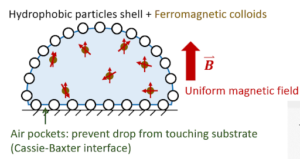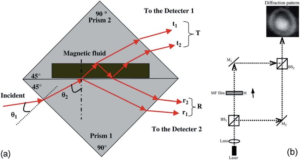Harnessing Magnetic Fields for Precise Ferrofluid Droplet Motion
Written by: Chad Park
Ferrofluids, composed of magnetic nanoparticles suspended in a carrier liquid, offer unique fluidic properties and can be manipulated by external magnetic fields. By employing varying magnetic fields on ferrofluids, controlling and manipulating them to explore their potential for innovative navigation systems becomes feasible. This capability to precisely control the movement of ferrofluids opens avenues for various fields, such as robotics, biomedicine, and microfluidics.
What are Water-Based Ferrofluids?
Water-based ferrofluids are colloidal suspensions that contain ferrous (iron-based) nanoparticles dispersed in water. A ferrofluid is a unique liquid strongly magnetized in a magnetic field. Ferrofluids, which are made up of ferromagnetic particles at the nanoscale floating in a carrier fluid, behave differently from other types of fluids in that the magnetic nanoparticles align themselves with the lines of an external magnetic field to generate complex patterns and structures in the fluid. Because of this magnetization property, ferrofluids exhibit fluidic behavior while keeping their magnetic properties. Magnesium and colloidal stability work together to give ferrofluids their distinct fluidic behavior. This makes it possible to precisely control and manipulate fluid motion in response to variations in the magnetic field’s strength and direction.
 Figure 1. Water-Based Ferrofluid Diagram
Figure 1. Water-Based Ferrofluid Diagram
Source: Northwestern Driscoll Lab
How is the Experiment Set Up?
The experimental setup uses high-speed cameras to image a ferrofluid drop on a hydrophobic substrate to observe its dynamics in real time. Three copper coil arrays (Helmholtz coils) are arranged to produce magnetic fields with adjustable parameters such as intensity and direction. Systematic experimentation and analysis are performed to measure the influence of magnetic field configurations on ferrofluid behavior. The ferrofluid drops can then be precisely controlled by modulating these fields.

Figure 2. Experiment Set Up with Helmholtz Coils
Source: Northwestern Driscoll Lab
Potential Applications
Ferrofluids are used in many different industries, such as energy harvesting, water purification, vibration control, biosensing, and medical imaging. Ferrofluids have a high sensitivity and specificity and are used in biosensing to identify infections and biomolecules. Ferrofluids’ ability to enhance contrast is advantageous for medical imaging techniques like magnetic resonance imaging (MRI) since it allows for better viewing of diseased states and anatomical structures. Ferrofluids are also used in the treatment of water, where they are used to remove pollutants and impurities using magnetic separation techniques. Within the field of energy harvesting, ferrofluid-based devices present viable ways to transform thermal or mechanical energy into electrical energy, advancing the creation of environmentally friendly power generation technology. Ferrofluids are also used in mechanical engineering to manage and dampen vibration in a variety of systems, improving longevity and performance. The main goals of current research projects are to improve stability, optimize ferrofluid synthesis techniques, and modify characteristics to suit particular application needs. The prospects for novel approaches to challenging problems across a range of industries are encouraging as ferrofluid technology advances, opening up new avenues for interesting discoveries and cross-disciplinary cooperation.

Figure 3. Optical Applications of Ferrofluids
Source: researchgate.net
Conclusion:
Ferrofluids offer a variety of characteristics that allow for exact manipulation using external magnetic fields, creating chances for innovation in a number of fields, such as microfluidics, biomedicine, and robotics. Water-based ferrofluids are used in biosensing, medical imaging, water purification, energy harvesting, and vibration control because of their distinctive fluidic and magnetic properties. Ferrofluid technology has the potential to solve difficult problems and promote interdisciplinary cooperation as long as research efforts are directed toward enhancing stability and synthesis methods.
References and Sources:
Chen, J., Xia, L., & Cao, Q. (2022). Water-based ferrofluid with tunable stability and its significance in nuclear wastewater treatment. Journal of Hazardous Materials, 434. https://doi.org/10.1016/j.jhazmat.2022.128893
Jara, D., Veiga, L. S., Garate, O., Ybarra, G., & Tancredi, P. (2023). Mass-production of water-based ferrofluids capable of developing spike-like structures. Journal of Magnetism and Magnetic Materials, 572. https://doi.org/10.1016/j.jmmm.2023.170622
Mao, L. (2015, May 14). What are ferrofluids? MAO LAB. https://magnet.engr.uga.edu/index.php/2015/05/14/what-are-ferrofluids/
Oehlsen, O., Cervantes-Ramírez, S. I., Cervantes-Avilés, P., & Medina-Velo, I. A. (2022). Approaches on Ferrofluid Synthesis and Applications: Current Status and Future Perspectives. ACS omega, 7(4), 3134–3150. https://doi.org/10.1021/acsomega.1c05631
Recent Progress in Ferrofluids Research: Novel Applications of Magnetically Controllable and Tunable Fluids – Scientific Figure on ResearchGate. Available from: https://www.researchgate.net/figure/Optical-applications-of-ferrofluids-a-Schematic-representation-of-a-ferrofluid-tunable_fig7_265475767